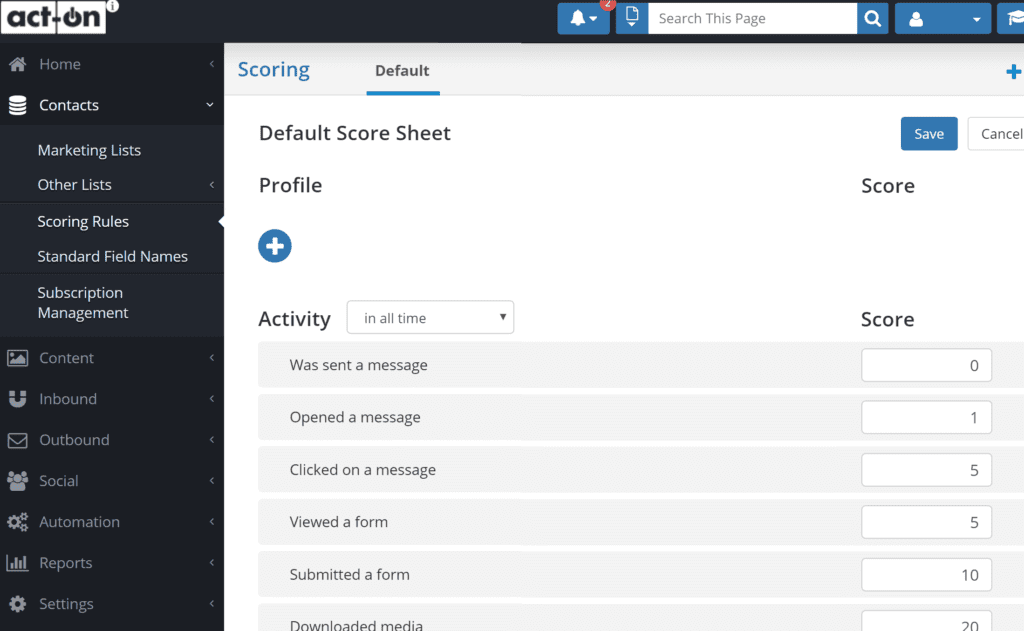Lead Scoring allows you to score potential leads based on their interactions on your website. This is needed to determine their quality and to allow you to focus on your top leads.
If a lead is not showing a lot of interest through their interactions on your website or through emails, then putting any marketing effort into them may lose you money, time and resources. As a marketer but also as a sales person you will want to be able to select the good from the bad. Implementing a Lead Scoring system can alleviate that pressure and you will be able to invest in your leads more accurately.
Act-On provides a Lead Scoring tool that is easy to set up and use. All you need to do is navigate in the menu bar to ‘Contacts’ and then select ‘Scoring Rules’. You will find predefined scores for interactions and activities such as email clicks, form submissions and web downloads but you can change or add further scoring rules to the existing list.

However, it is not just as easy as assigning points to activities. The scoring system needs to be well researched and thought out in order to be effective.
3 Top Tips to consider when designing your Lead Scoring system
1) Identify your target customer
With Lead Scoring you can assign points to potential customers based on key characteristics that are most often associated with potential and current customers. Therefore, the main consideration should be ‘Who is my typical buyer?’. If, for example, you offer your products and services in the UK only and you have a website visitor with high activity but with a location outside of the UK, then you want to take this demographic factor into consideration when applying a lead score.
Thoroughly identifying who your target customers are will help you establish a more accurate scoring system for website visitors and email recipients.
2) Score data based on its relative value
The Lead score will only be beneficial if the points given are based on interactions that are valuable to your business. You might want to allocate a visit to your products page with 10 points. If a document is downloaded, this might be an additional 20 points and if an enquiry form is submitted, you might want to add another 30 points to the visitors score.
But a visitor with high website activity does not necessarily mean that there is a potential interest in your products and services. If the focus is lying on your careers page then it is likely that their interest is not in becoming a customer of yours and this should therefore be highlighted as such by deducting for example 50 points.
Take your time in defining which points you want to allocate to activities and interactions on your website or through email to determine who your top leads are. The higher the leads’ point value, the more focus and effort you should put into selling to them.
3) Don’t over complicate the Lead Score Process
Keeping your scoring system simple will make your Lead Scores more valuable and easier to interpret. Masses of segments would obliterate this as less relevant collected data will make it more difficult for you to identify the actual valuable interactions.
When setting up Lead Scoring in Act-On, it is important to concentrate all initial efforts on analysing interactions on your website and through emails and finding out which pages, links, and forms show the most interest in your company and which pages perhaps are irrelevant in knowing if those visits are linked to people wanting to become customers. Not every page on your website has to be scored in a different way. Remember to start simple with only a handful of segments. You can always add more to your scoring system.
Investing time in identifying who your target customers are and deciding on an accurate but simple to read Lead Scoring system will pay off in the long run as you will gain further knowledge of your potential buyers behaviour and you will be able to act on this accordingly.





